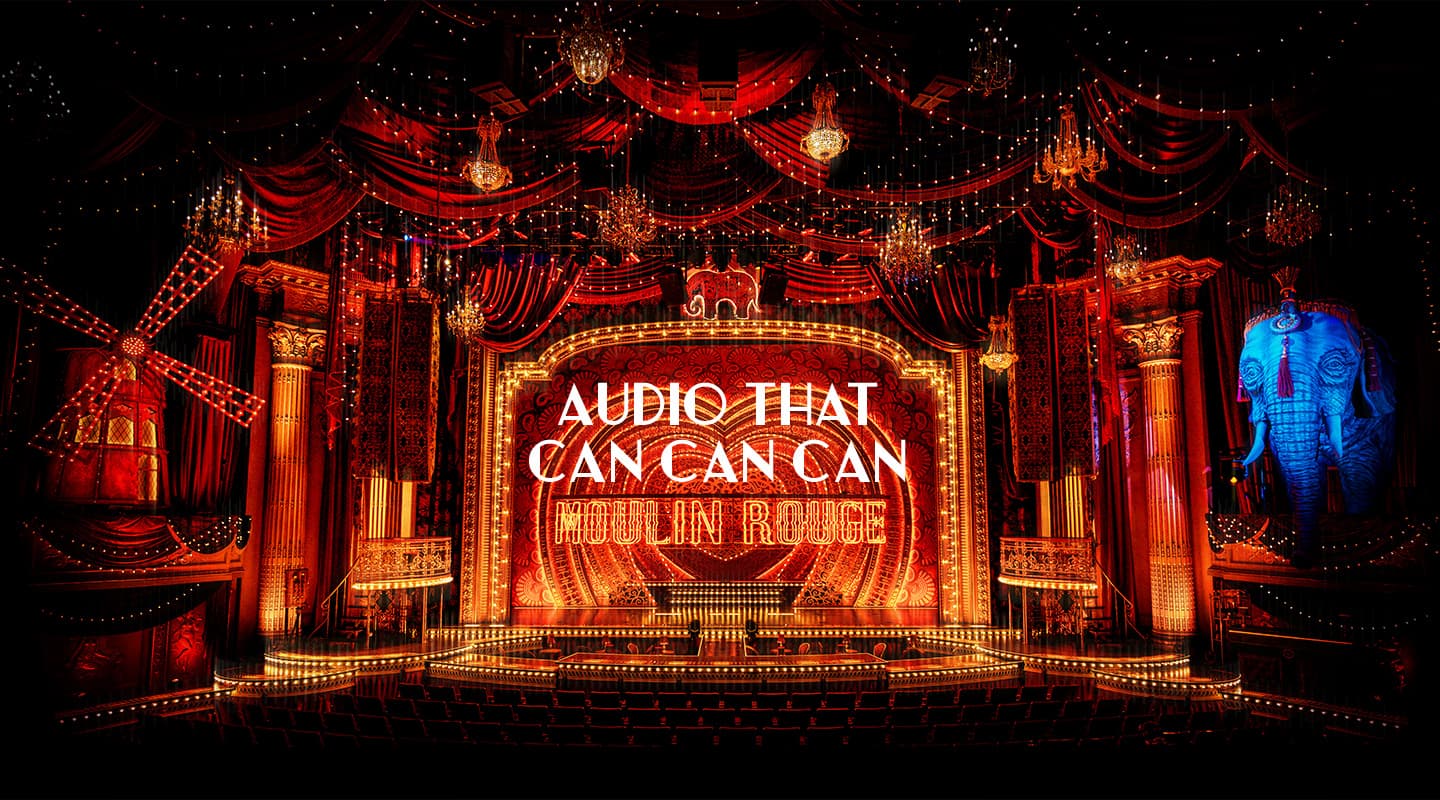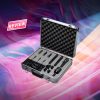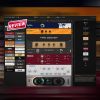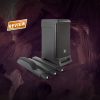
Moulin Rouge! The Musical Live
The Moulin Rouge musical production is lavish and spares no expense in giving every audience member the ultimate audio experience.
Meyer Sound’s 900-LFC sub is a monster. If you see them in an install, then a handful will be all that’s required. An arena tour might need eight a side. The Moulin Rouge! The Musical production (produced by Australian live entertainment company Global Creatures and staged out of Melbourne’s Regent Theatre, at the time of writing this story) has 21. Of course, 21 is an odd number… in both meanings of the word. Surely an odd number of flown subs would mean an unbalanced audio design – leaning more to one side of the theatre? Never fear, the 21st (or the first?) is under the Digico mixing console of the operator, Chris Pratt. That’s right, Chris gets his own, personal 3000W/A$10,000 18-inch subwoofer to ensure he enjoys the same experience as those in the front rows of the stalls. (Minor clarification: there are an additional two 1100-LFC subs in the design on top of the 21 x 900-LFCs.)
That’s just one example of how the Moulin Rouge! The Musical (we’ll just call it ‘Moulin Rouge!’ from here on for the sake of brevity) audio design brings together the absolute best of everything. Obviously there’s a budget but it’s hard to see any signs of compromise. The designer, Peter Hylensky, is a Broadway heavyweight (King Kong, Frozen, Rock of Ages, Shrek, et al). He worked with Australian theatre specialist rental company, System Sound, on specifying everything required for the Australian run of the show, which has been in theatres since 2021. It’s been a crowd favourite, combining the Baz Luhrmann Moulin Rouge story with a long list of contemporary ‘bangers’ and sing-along favourites.

THEATRE OF DREAMS
Musical theatre is an interesting audio discipline. There can be similarities to a touring pop/rock act. But there are also plenty in common with dramatic theatre. Traditionally you have performers wearing omnidirectional lavalier mics in their hairline, without any vocal foldback, singing along to a live band which is normally in the orchestra pit in front of the stage.
With technology improvements, sound designers like Peter Hylensky have been able to push the boundaries of what’s possible. Intelligibility has improved, SPLs in the house have been pushed harder, improved stage monitoring is possible, headworn mics and transmitter packs have got smaller, battery tech is better, and a lot more is possible with creative routing to loudspeaker systems and surround setups.
The Australian Moulin Rouge! sound design represents the absolute state of the art when tech rehearsals started in 2021. The big-ticket items include a huge complement of Meyer Sound loudspeakers and Galileo Galaxy processors; dozens of channels of Sennheiser Digital 6000 wireless; and a fully-maxed Digico Quantum 7 mixing console.
AudioTechnology met with System Sound production sound engineer, Chris Pratt, and sound associate David Greasley at the Regent Theatre in downtown Melbourne to get a closer look at the technology that makes the show tick.
MIXING THE SHOW
So what’s it like mixing a full-throttle musical theatre show like Moulin Rouge! ?
Chris Pratt: “Intense. The first 20 minutes, especially, are absolutely relentless. There’s a lot of manual mixing of the main vocals and getting the band balance just right. I’ll also be hitting sound effects. Some of the effects are linked to visual cues so they can’t all be trigged by QLab. You need to know the show to get it right. And, being theatre, you’re not going to get the exact same performance every night – you need to stay alert. If you miss a cue, then there’s nowhere to hide — everyone will know about it.”
As you can imagine, the show is heavily snapshotted.
Chris Pratt: “The snapshots will be changing band mix assignment on your DCAs; changing reverb sends; making EQ changes, that sort of thing. The automation may be rebalancing the ensemble for you as a starting point but it’s not changing anything to do with principal vocal levels, those are always mixed manually.”
With 30+ wireless mics, dozens of band inputs, Ableton tracks, sound effects and more, there are plenty of inputs to wrangle:
“We’re full. We run a Digico Quantum 7 with an EX-007 sidecar for front of house, connected to a couple of SD racks, a SD-Nano Rack and SD-Mini Rack backstage — and they’re all full. We’re also running an Orange Box and an Optocore DD4MR. So that’s how we get all of our inputs into our system. The Quantum 7 has been upgraded to 32-bit internal processing. But we run analogue copper to the Meyer Sound Galileo Galaxy processors. We have 11 of those which are themselves interconnected via AVB – effectively turning them into one huge crosspoint matrix – which routes audio to our Meyer Sound distributed sound system.”




Moulin Rouge! uses a true distributed loudspeaker design – push the main fader up and every FOH speaker lifts. The rig is based on Meyer Sound loudspeakers except for some d&b E6 and E8 sound FX speakers. 14 Leopard and eight 900-LFC a side comprise the main array. That’s supplemented by many fill and delay loudspeakers, as you can see from these images. Including, 24 x UPJuniors as delay speakers option, venerable MSL-4s as dress circle centre fill, brand new ULTRA-X40s, and lot and lots of compact MM-4XPs as front fill and as stage monitoring (see the grilles in the stage).
THE SOUND RIG
Main FOH:
14 x Meyer Sound Leopard per side
FOH Sub Arrays:
15 x Meyer Sound 900-LFC &
2 x Meyer Sound 1100-LFC
Fill Speakers:
6 x Meyer Sound UPQ-D & 2 x Ultra-X40
Front fill (Stage & Passerelle):
48 x Meyer Sound MM-4XP
Delays:
4 x Meyer Sound UPM-1XP & 4 x MM-10ACX
Stalls Delays:
20 x Meyer Sound UPJuniors
Circle Delays:
4 x Meyer Sound UPQ-1P
4 x Meyer Sound 750-LFC
Circle Mid-house Delays:
3 x Meyer Sound MSL-4
On Stage Foldback:
36 x Meyer Sound MM-4XP
4 x Meyer Sound UPM-1XP
4 x Meyer Sound MM-4XP
Passerelle Table Lamps:
36 x K-Array Lyzard ultra-miniature line arrays
Surrounds:
62 x d&b E8
Audio Matrixing:
11 x Meyer Sound Galileo Galaxy 816
Console:
Digico Quantum 7
Digico X-Q7-EXP EX-007 Expander
Radio Mics:
36 channels of Sennheiser Digital 6000 with miniature SK6212 transmitters
Comms:
Clear-Com HelixNet & Clear-Com FreeSpeak II wireless
LEOPARD COVERS ALL SPOTS
Musical theatre has always been a law unto itself with panning, routing and surrounds. In the past, an entirely parallel vocal system might be a feature. Ultimately, the idea has always been about doing whatever’s necessary to improve vocal intelligibility, which is tough when performers are whispering into gained-up omni mics or bellowing into each other’s lavs during a showstopper duet.
Moulin Rouge! works with a true distributed loudspeaker design. Fundamentally, the aim is to get the best, most suitable loudspeaker as near to the relevant section of the audience as possible.
Leading the charge is an array of Meyer Sound Leopard each side, 14 deep, with eight Meyer Sound 900-LFCs in a cardioid configuration flown beside it. If Moulin Rouge! was a touring pop act, this rig would probably all you need (with a bit of underbalcony fill). But Peter Hylensky’s design goes much much further. There are Meyer Sound point sources loudspeakers providing centre channel coverage, delay and fill to the whole 2500-seat theatre.
David Greasley: “I think we’ve got the whole Meyer Sound catalogue on this show! 28 Leopards, 20 x 900-LFCs [plus Chris Pratt’s personal sub! – Ed.], and a couple of 1100-LFCs. I don’t even know how many MM-4XPs… 34, I believe, mostly in the stage. We’ve got a lot of UPJuniors… there must be at least 30 of them. Then there are lot from the Meyer Sound UPM range: -2Ps, -1Ps, UPM-1s, UPM-1XPs plus UPQ-D1, -D2s and -D3s. A couple of the ULTRA-X40s… We’ve even got a few of the old MSL-4 from the ’90s, which still sound amazing! Then the surround system is the E6 and E8 from d&b.”
Chris Pratt: “The design is based around Leopard because that’s the best-sounding array box of that size. The same applies to the 900-LFC. It sounds fantastic. Running them in cardioid gives us an exceptionally even sound through the house. The other Meyer Sound point source loudspeakers were all chosen to provide the very best coverage for every seat in the house.”
David Greasley: “The UPQ loudspeakers and the MSL-4s are used to progressively keep a high-powered full-range box in the centre, and that feeds all the way through the room in order to get that full-range centre sound the show needs to maintain a hifi sound. It’s tightly plotted such that each speaker hands over at the 6dB-down points, again, to keep it smooth through the room so every person has the same experience.
“Being a distributed system, it doesn’t shift around – it’s one large cohesive audio experience.”
Chris Pratt: “And because we have so many speakers in the room, it’s very responsive to fader moves. Nothing’s running too hard, and nothing’s near its limit. You have full clarity as you push up and down in the room. If you push the master fader by 1 or 2dB you can really hear it.”

CABARET MODE
Another example of the sound design going above and beyond, takes us to the primo cabaret table section right up the front of the seating area. This ‘Passerelle’ section (as it’s known) gives cashed fans and musical theatre tragics the ultimate experience, where couples sit at their own high table, quaff absinth (okay, maybe champagne), and not only have the show being staged in front of them but around them.
Chris Pratt: “A lot of a lot of the show is set in front of the proscenium on a T-shaped stage thrust – it’s an extra runway and forms a barrier which encloses the special cabaret seating area where the show can be happening behind them, around them, as well as in front of them. Those people need vocal clarity like everybody else, so they have Meyer Sound MM-4XPs cube speakers down the front, giving them directional sound from stage but they also need something more localised. Each table has a lamp and in that lamp we’ve integrated two tiny K-Array Lyzard speakers – they’re not much bigger than a matchbox. They’re small but they do an amazing job and providing extra vocal clarity and localisation of the sound.”
David Greasley: “When you’re in that seating area, you’re out of the main system’s pattern. So you’ve got a lot of off-pattern sound to overcome there – you’ve got about 200 loudspeakers behind you shooting into the room – as well as sound coming back from the house. So to maintain the best possible intelligibility, you need speakers close to you and the Lyzards do that job. You’re not even aware that they’re active but they bring a real sense of clarity to the vocals, especially.”
ROUTING & LOCALISATION
There’s no stereo bus out of the mixing console. The band mix is fundamentally mono and level-only. Special effects can be routed to particular loudspeakers. Vocals are treated differently. Every effort is made to place lead vocalists’ audio in the right spot, matching their stage position. There are 10 possible on-stage zones that help the audience localise the performer to their stage position. Which is all to say, Chris Pratt doesn’t use ‘panning’ to localise performers as they strut the stage, instead the localisation is performed using delay between loudspeakers, otherwise known as the Haas effect, and something theatre has been employing for a long time.
There are 30+ outputs from the console feeding the Meyer Sound Galileo Galaxy processors. The Galileo Galaxys themselves act as a crosspoint matrix for the vocals – any vocal source to any output. During the painstaking loudspeaker tuning process, the audio team set up microphones in the room and put a source loudspeaker in one of the 10 on-stage zones, then time every send of the loudspeaker system to the source. Rinse and repeat 10 times (up/down stage and left/right).
Given the show is heavily staged, the audio localisation of performers is automated, there’s no need for IR trackers or the like.
“The localisation of vocals is important for this show,” remarked Chris Pratt. “Given it’s high energy, it allows the audience to more easily connect with performers especially when there are multiple vocalists.”

We need to have that full-range HF experience in each seat in order to be able to get that message across.
STAGE MONITORING
If the loudspeaker routing seems crazy-intricate and involved, then the on-stage monitoring isn’t far behind.
First up, you’ll very rarely find in-ear monitoring on a musical theatre stage. The sense is that audience connection is everything and performers are loath to do anything that might undermine that and the interactions between fellow performers.
That said, performers still benefit from hearing vocal foldback so they can pitch properly.
But any foldback needs to be heard but not seen. Not only that, any unnecessarily stage spill will decrease intelligibility in the house mix – don’t forget, performers are using omnidirectional headworn mics, not hypercardioid handheld mics, and pick up everything.
So, you guessed it, Moulin Rouge! features one of the world’s most sophisticated foldback setups.
Concealed beneath a grille under the feet of the performers are rows of miniature Meyer Sound MM-4XP loudspeakers – six each in the first three rows and four each in the back two rows, 26 in all. Part of the snapshot automation sees foldback being routed to the correct combination of underfloor loudspeakers depending on the position of the principals and whether they’re actively singing.
Performers on the stage thrust in front of the proscenium aren’t forgotten. There are another six Meyer Sound MM-4XP.
For complete coverage, performance ladders flown on/off stage have additional sidefill-style monitors – Meyer Sound UPJuniors. And for performers side of stage, there are additional monitors. Finally, certain set pieces rolled on/off stage have monitoring onboard. Given they’re unattached, those speakers are battery powered and accept their monitor send via a wireless pack. Phew.
WIGGING OUT: WIRELESS
Musical theatre has a voracious appetite for wireless headset mics. Every performer with a singing or speaking part gets one, and it’s good practice for principal performers to wear a backup. Traditionally, the audio department would work with the wigs and wardrobe departments to place a lav mic in the hairline of the performer then run the cable underneath the costume to a well-concealed pack.
Peter Hylensky’s audio design opts for headset mics instead of hairline mics. Although the frequency response from a hairline mic is remarkably good, you’re still twice as far from the source (the mouth) than a headset mic. But headset mics have disadvantages. They’re visible and they’re hard to get a perfect fit, especially when the performer is dancing.
Peter Hylensky’s answer was to get every performer individually fitted with a bespoke headset. Each headset is made from titanium (light, strong and hypo-allergenic) and fitted high on the back of the head and over both ears. The boom extends about half way to the performer’s mouth and camouflaged to blend in with the tones of the makeup. Courtney Weaver was appointed wireless guru and oversaw all this.
Sennheiser’s MKE1 capsule was specified thanks to its diminutive form factor and its natural response. Ditto the Sennheiser 6121 transmitter pack, which is small enough to be clipped in under the women’s wigs, meaning one less cable to worry about, especially if there are costume changes.
David Greasley: “We have 38 channels of Sennheiser’s Digital 6000 Series wireless. We use the 6212 belt packs which are waterproof, which is great – previously we’d need to wrap packs in latex in order to stop sweat getting in.”
Chris Pratt: “The other thing that really saves us time is the battery life on the latest generation of wireless. We can now go a full day of technical rehearsals or a full double show day without changing batteries. It might not sound like a big deal but previously, during changeovers, when everyone else was getting a break, we’d be laboriously swapping out batteries on all the packs. Now we get a break.”
David Greasley: “The titanium headsets are great. They’re a perfect fit and don’t move. We spend a lot of time getting the distance to the mouth just right so we don’t get any breath noise while still getting maximum vocal output. So once we’ve finessed that, it’s a real advantage knowing that capsule is in the exact same spot every night.”
Chris Pratt: “Location to the mouth is a massive thing. With a boom headset, it can make a huge difference up front for intelligibility and the amount of gain you can get. It means that I’m able to mix that vocal above the band in those big moments – and there are plenty of big moments in this show. In fact, we need to hear every syllable without the breath noise.”
David Greasley: “The Sennheiser MKE1 is super-compact but it’s also such a good-sounding microphone. The principals wear two boom mics so they can’t afford to be obtrusive, but you can’t sacrifice clarity.”
Chris Pratt: “The MKE1 provides that clarity without any artificial boost in the frequency response. You’re not fighting against some kinda baked-in boost.”
David Greasley: “Combine that with the solid clarity in the high end you get from the 6000 series and it’s just so strong. It’s a solid system.”

BIG, BAWDY & BEAUTIFUL
Moulin Rouge! is big, bawdy and loud, but its success hinges on ensuring the audience hangs on for the roller coaster ride. Unlike a Les Mis or a Phantom of the Opera or even a Wicked, Moulin Rouge! doesn’t rely on traditional musical theatre principles, such as recurring musical themes. Instead, the songs are already radio favourites, known to all in the audience and are often coming hard in mashed-up medleys.
David Greasley: “Dynamic range is really important but it’s not just dynamic range that we’re giving audiences. We’re giving them the story and we’re giving them the pop songs; we’re giving them the hooks, and a lot of the music in the show. We’re not playing the same recurring song from throughout, in fact, we might be doing four different songs in quick succession or even two songs at once. So whenever there’s a change in the music, the audience needs to know straight away. We need to have that full-range HF experience in each seat in order to be able to get that message across.”
Clearly it’s doing it rather well. It’s rare to witness an audio design that doesn’t routinely accept compromises. Every technical challenge is addressed with an ingenuous technical solution. The result is an exceptional experience for audiences.
Moulin Rouge® is a registered trademark of Moulin Rouge.

BAND
The band room is several floors up in a dedicated room above the foyer. This creates some wildly long cable runs, and a serious jog at the end of every performance for the MD to take his bow.
































RESPONSES